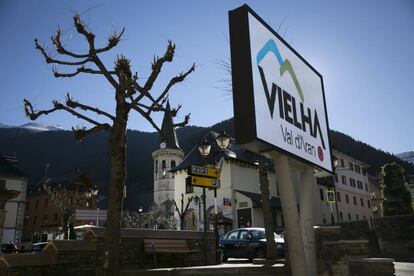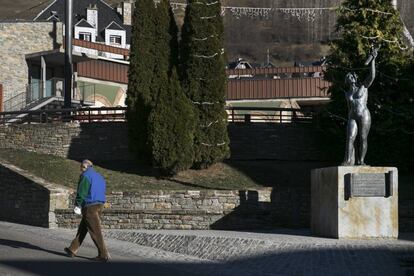Catalonia’s independence-free zone
The Val de Arán is only area of the region where supporters of secession are in a clear minority

The first time Vanessa Folgar came across the Catalan pro-independence estelada flag was when she left the Val de Arán to study in Lleida. In the area where she had been living from the age of two, nobody flew the flag or talked about secession from Spain. Folgar is now 33 and an elementary school teacher in Gessa and not much has changed. She still doesn’t see the distinctive red and yellow striped estelada flags in the valley.

An unusual corner of Catalonia, the Val de Arán (Aran Valley) is located on the northern slopes of the Pyrenees and enjoys the distinction of being the only place in the region with an Atlantic climate. It is also the only region in Europe where the Occitan language is thriving. And it is the only region in Catalonia where supporters of independence are in a clear minority.
Folgar speaks to EL PAÍS while sitting in the playground of her school under a warm sun. High up beyond the distant fir forests, you can just make out the region’s cash cow – the ski station of Baqueira, which is used by almost three times as many tourists from the rest of Spain as from Catalonia.
The previous mayor had a portrait of the Catalan premier, but I put it in the storeroom Amador Marqués, Mayor of Bossòst
Folgar speaks Catalan and Aranese perfectly. The local dialect of Occitan, Aranese is an official language in Catalonia and the language used in schools, though Spanish, Catalan, English and French are also on the curriculum. The pupils’ work on the classroom wall is in Aranese, as are the school notices. “I don't know anyone who is pro-independence but I do know people who are Occitan nationalists,” she says. “Independence is considered a problem because it generates uncertainty – it would force the area to decide if it wanted to be part of one or the other (Spain or Catalonia) and people are fine as they are.”
The Val de Arán has 10,000 inhabitants. It is a strategic border enclave that has been autonomous since the 14th century. There are no monuments or streets named after Catalan heroes such as Lluís Companys – the Catalan premier executed in 1940 on the orders of General Francisco Franco during the Civil War – or fellow former regional premier Francesc Macia.

In the 2015 Catalan regional elections, the Junts pel Sí coalition between the pro-independence Democratic Convergence of Catalonia (CDC) and the Republican Left of Catalonia (ERC) obtained 39.5% of the votes in Catalonia as a whole but only 25% in the Val de Arán. Meanwhile, the left-leaning pro-independence Popular Unity Candidacy (CUP) took 8% of the vote in Catalonia and only 6% in Arán. In the Spanish general elections last June, the conservative Popular Party of current Prime Minister Mariano Rajoy won in Arán’s main towns – Vielha and Naut Aran – and the socialists in the third biggest town, Bossòst, while the CDC and ERC came in last.
The owner of the Er Areu de Les bookshop, Elvira wears a gold Occitan cross around her neck. Her daughter Maite is a nurse at the hospital in Vielhawhere she got a job after graduating from the Rovira i Virgili University in Tarragona. They both consider themselves to be Aranese first and Spanish and Catalan second and they are convinced that everyone in the area feels the same. “The independence debate doesn’t affect us much,” says Elvira. “Maybe the Catalans who live here take it more seriously.
I don't know anyone who is pro-independence but I do know Occitan nationalists Vanessa Folgar, school teacher
Joan Pascual is from Barcelona but has lived in the Val de Arán for 20 years. He has a catering business in Arties and, as a Catalan, he is more in tune with the independence movement,but he also understands the Aranese take on it. “The Val is the only region in Catalonia that depends almost exclusively on tourism and, more specifically, on tourists from Madrid, the Basque Country and Valencia, who are loyal to the area,” he says. “Those who are in favor of independence are not hardliners. There are no demonstrations or political meetings here.”
Jusèp Loís Sans Socasau and Jèp de Montoya are in charge of the Institute for Aranese Studies (IEA), which was set up in 2014 along the lines of the Institute for Catalan Studies. Sans Socasau also founded the local branch of the ERC in 2008 and in the reception area of the IEA there is a map of the Catalan and Occitan territories. Montoya points out that, unlike other places in Occitania, Arán has been fortunate because Catalonia has understood and respected its singularity, noting:“The Val de Arán has sought close ties to Catalonia.”
Sans Socasau believes that Spain looks more positively on the Val de Arán because of the influx of Spaniards from outside, many of whom take jobs as civil servants – either as policemen, postmen or, until recently, army personnel. Some 40% of Aranese have immigrated from the rest of Spain while in Catalonia the figure is 33%.

But however many residents come from outside the region, the mayor of Bossòst, Amador Marqués, believes that the Aranese identity is about bringing people together. “It's not about giving up being Spanish or Catalan,” he says.
Marqués’s office is only decorated with an Aranese flag and two oil paintings of Bossòst. “The previous mayor had a portrait of the Catalan premier but I put it in the storeroom. I’m not much of a one for protocol,” he says.
English version by Heather Galloway.
Tu suscripción se está usando en otro dispositivo
¿Quieres añadir otro usuario a tu suscripción?
Si continúas leyendo en este dispositivo, no se podrá leer en el otro.
FlechaTu suscripción se está usando en otro dispositivo y solo puedes acceder a EL PAÍS desde un dispositivo a la vez.
Si quieres compartir tu cuenta, cambia tu suscripción a la modalidad Premium, así podrás añadir otro usuario. Cada uno accederá con su propia cuenta de email, lo que os permitirá personalizar vuestra experiencia en EL PAÍS.
¿Tienes una suscripción de empresa? Accede aquí para contratar más cuentas.
En el caso de no saber quién está usando tu cuenta, te recomendamos cambiar tu contraseña aquí.
Si decides continuar compartiendo tu cuenta, este mensaje se mostrará en tu dispositivo y en el de la otra persona que está usando tu cuenta de forma indefinida, afectando a tu experiencia de lectura. Puedes consultar aquí los términos y condiciones de la suscripción digital.
More information
Archived In
Últimas noticias
Most viewed
- Why we lost the habit of sleeping in two segments and how that changed our sense of time
- Trump’s obsession with putting his name on everything is unprecedented in the United States
- Pablo Escobar’s hippos: A serious environmental problem, 40 years on
- The Florida Keys tourist paradise is besieged by immigration agents: ‘We’ve never seen anything like this’
- Charles Dubouloz, mountaineering star, retires at 36 with a farewell tour inspired by Walter Bonatti











































